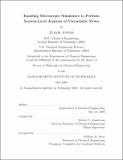| dc.contributor.advisor | Robert C. Armstrong. | en_US |
| dc.contributor.author | Anwar, Zubair | en_US |
| dc.contributor.other | Massachusetts Institute of Technology. Dept. of Chemical Engineering. | en_US |
| dc.date.accessioned | 2008-11-07T14:12:33Z | |
| dc.date.available | 2008-11-07T14:12:33Z | |
| dc.date.copyright | 2008 | en_US |
| dc.date.issued | 2008 | en_US |
| dc.identifier.uri | http://hdl.handle.net/1721.1/42943 | |
| dc.description | Thesis (Ph. D.)--Massachusetts Institute of Technology, Dept. of Chemical Engineering, 2008. | en_US |
| dc.description | This electronic version was submitted by the student author. The certified thesis is available in the Institute Archives and Special Collections. | en_US |
| dc.description | Includes bibliographical references (p. 249-261). | en_US |
| dc.description.abstract | State-of-the-art methods for simulating viscoelastic flows couple the conservation equations for mass and momentum with a model from kinetic theory that describes the microstructural state of the polymer. Introduction of appropriate numerical discretization and boundary conditions for these equations leads to a hybrid simulation for studying the dynamic behavior of polymeric liquids in complex geometries. This approach represents a rare example of a successful multiscale solution of a physical problem, as it allows investigation of arbitrary models of kinetic theory. The simulations, however, are not amenable to standard numerical techniques for system-level stability, bifurcation, and control analysis as this requires closed form equations. These simulation either use stochastic descriptions for the polymer microstructure that cannot be reduced to closed form, or involve equations for the evolution of a distribution of polymer conformations, which can only be written in closed form by invoking mathematical closure approximations that can have a significant qualitative impact on the predictive ability of these simulations. The focus of this thesis was to develop a novel numerical method that can enable hybrid simulations to perform system-level analysis of polymeric flows. This numerical approach has been applied directly to kinetic theory models and hybrid simulations to obtain stationary states and associated bifurcations and stability information. The method is general in its applicability in that it treats kinetic theory models and hybrid simulations as black boxes that are then used to obtain system-level information without any modification. The methods developed here are illustrated in a variety of problems. | en_US |
| dc.description.abstract | (cont) Steady state results have been obtained for the non-interacting rigid dumbbell model in steady shear, and for the free-draining bead-spring chain model in both steady shear and uniaxial elongation that are in excellent agreement with previous studies and steady state computed from direct integration. The method is also applied to a hybrid simulation for the pressure-driven flow of non-interacting rigid dumbbells in a planar channel with a linear array of equally spaced cylinders. The computed steady state is in agreement with direct integration and qualitatively matches previous computations with closed models. Bifurcation analysis has been performed for the Doi model at equilibrium with the Onsager excluded volume potential. This analysis agrees with previous studies and accurately predicts the isotropic-nematic transition and turning point for the unstable to stable transition on the prolate solution branch. Bifurcation analysis has also been performed for the Doi model in the weak shear flow limit for the Maier-Saupe excluded volume potential. It is found that stable stationary solutions are lost at a limit point beyond which time-periodic tumbling orbits are the only stable solution. This transition occurs via an infinite period global bifurcation, while the limit point approaches a threshold value as the shear rate approaches zero. This result matches a recently published scaling analysis and demonstrates the ability of the method to provide general bifurcation analysis of kinetic theory models. Stability analysis of the fiber-spinning process for polymeric fluids has also been performed by using a hybrid simulation that couples the one-dimensional conservation equations for mass and momentum with a stochastic description for the configuration fields of the Hookean dumbbell model. The steady-state velocity profiles are in good agreement with previous studies with the Oldroyd-B model. | en_US |
| dc.description.abstract | (cont) The analysis predicts onset of the draw resonance instability via a Hopf bifurcation and subsequent stabilization via second Hopf bifurcation in draw ratio parameter space. This result is in good agreement with experimentally observed behavior during polymer fiber-spinning. | en_US |
| dc.description.statementofresponsibility | by Zubair Anwar. | en_US |
| dc.format.extent | 261 p. | en_US |
| dc.language.iso | eng | en_US |
| dc.publisher | Massachusetts Institute of Technology | en_US |
| dc.rights | M.I.T. theses are protected by
copyright. They may be viewed from this source for any purpose, but
reproduction or distribution in any format is prohibited without written
permission. See provided URL for inquiries about permission. | en_US |
| dc.rights.uri | http://dspace.mit.edu/handle/1721.1/7582 | en_US |
| dc.subject | Chemical Engineering. | en_US |
| dc.title | Enabling microscopic simulators to perform system-level analysis of viscoelastic flows | en_US |
| dc.type | Thesis | en_US |
| dc.description.degree | Ph.D. | en_US |
| dc.contributor.department | Massachusetts Institute of Technology. Department of Chemical Engineering | |
| dc.identifier.oclc | 259086368 | en_US |
